| DIRECT-TO-GARMENT VS DYE SUBLIMATION FABRIC PRINTING |
 |
|
Printed T-shirts have a wide range of personal and commercial uses. From one-off bachelorette parties to corporate baseball or bowling team jerseys, garment printing allows anyone to customize their clothing with their logo, favorite saying, or graphic image.
Depending on the intended use of the garment, the customer may require their t-shirt to last through a one-night event, or be color fast through hundreds of washes. For the former, a simple iron-on decal print, available from some print shops or self-made with a desktop printer, will generally do the trick. For a practical garment that holds up to wear and tear, higher quality methods are necessary.
Screen printing techniques are still a very popular option for long-lasting printed garments. Two alternate options for printing on fabric are direct-to-garment printing and dye sublimation. While both methods use inkjet printers and inks to produce a smooth result without the excess material of a decal, there are many differences between these practices, from materials required to uses to longevity.
|
SUMMARY
DTG Direct To Garment Printing requires a special printer and inkjet textile inks. The material is fed through the printer and a digital image is transferred straight onto the t-shirt or other fabric. DTG printing works best on cotton or cotton blend materials.DTG prints are limited to a 16" x 20" print size and can be impeded by seams or the contour of the garment.
Dye Sublimation Printing uses special inks in a regular inkjet printer to create an image on transfer paper, from a digital file. The image is then relocated onto the fabric using heat and pressure. The fibers of the material are infused with the color from the transfer sheet. Sublimation is for synthetic materials and requires specially treated fabrics such as polyester or polymer fabrics.
|
| The following article outlines the tools and processes involved in both methods, as well as other things to consider when choosing to print onto fabric using one of these techniques. |
| DIRECT TO GARMENT PRINTING
|
 |
|
Also called DTG, digital direct to garment, and digital apparel printing, direct to garment is a process of using an inkjet printer with special inks and technologies to print straight onto fabrics - textiles and clothing.
Two primary tools are required for DTG printing:
- A special transport mechanism to move the fabric through the printer
- Special inks - called inkjet textile inks - that are absorbed by the material when they are deposited onto it.
The printers used for DTG printing are derived from ordinary desktop inkjet printers. Depending on whether the printer will be used to create clothing or signage, it may be capable of high or lower quality resolution. DTG printers use 4 ink colors (Cyan, Magenta, Yellow, Black), which can create a wide range of colors when mixed in various combinations.
Originally, direct printing to dark fabrics was not successful, but some manufacturers have improved the process to make it possible. The darker garments must be treated prior to printing, however, which makes them more costly.
Additionally, DTG printing works best on cotton or cotton blend materials. Most DTG prints on blended fabrics will appear faded since the color will seep into the cotton strands, but not the other material. There have been some improvements made recently which allow for certain printers and inks to successfully print on non-cotton fabrics.
When DTG printing was first developed, it was popular due to its ability to produce small runs of projects. Screen printing, the primary means of garment decoration previously, is only viable for high quantity runs due to the cost and time required to set up the process. Similar to screen printing, however, there is a usually size restriction for DTG prints of approximately 16" x 18".
|
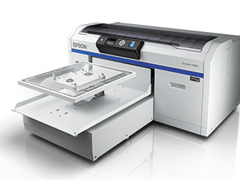
Epson SureColor F2000 Series, printing directly to garments
5-color Direct-to-Garment Printer
Ultrachrome DG inks
1440 x 1440 dpi for white ink
1440 x 720 for color inks
Garment imaging area: 16" x 20"
|
| DYE SUBLIMATION PRINTING
|
 |
|
Unlike DTG printers, those used for dye sublimation do not require any alternate manufacturing or replacement parts. Any ink jet printer can be used for dye sublimation as long as that model has dye sublimation inks manufactured for it. This is because the fabric never enters the printer in the sublimation process.
The mirror image of the digital file is printed onto a special transfer paper, which is then placed face down on the fabric and affixed with a heat press. When heated, the polyester expands and absorbs the inks, which have sublimated into a gaseous state. When the fabric cools afterwards, the polyester fibers contract, trapping the dyes permanently. While DTG printing works on cotton, dye sublimation only works on polyester or polymer-treated materials.
Alternately, some dye sublimation printers can print directly to fabric as well, though the process taking place within the printer is the same. The garment is heated, and when the gaseous ink is applied it is absorbed into the fibers of the material. Both transfer sheet and direct printing are viable options for dye sublimation.
Instead of only four colors, dye sublimation ink cartridges come with anywhere from four to eight colors (generally CMYK, and some "light" versions of those colors). The extra colors available for dye sublimation allow for more precise color matches that better emulate the colors in the digital image - skin tones in photographs, for instance. For this reason, dye sublimation is more popular for photographic reproductions, while DTG works perfectly well for graphic applications.
Because dye sublimation prints can be created on any printer, there is less limit to the size that can be created. Each print company is limited only by the size of their printer and heat press. Alternately, if the printer or heat press is small, a repeated design can be created on a garment by exposing different sections to the heat press with separate transfer papers.
|
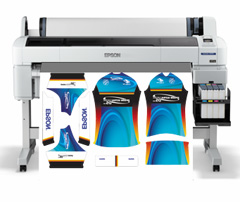 UltraChrome DS inks
Print quality: 720 x 1440 dpi
Speed: up to 682 SFPH
Epson MicroPiezo TFP print head
Ideal for flatbed heat transfer press application
UltraChrome DS inks
Print quality: 720 x 1440 dpi
Speed: up to 682 SFPH
Epson MicroPiezo TFP print head
Ideal for flatbed heat transfer press application
|
| OTHER CONSIDERATIONS
|
 |
COLORED FABRIC
You may note that neither of the ink cartridges mentioned above use white ink. This is because inkjet inks, as a whole, do not use white ink. Because the surface onto which most images are printed - paper, canvas, etc - are generally white themselves. Any white in the digital image will simply be left uncolored in the printed image.
This is rarely an issue for printing on paper, but when colored fabrics are introduced, the absence of white can become an issue. Any areas that were white on the digital image will now be the pink or blue, for instance, and paler colors will appear washed out.
As a result, white fabric will always offer the best result. In recent years, however, white ink has been created and utilized for DTG printers with some success. Though early versions tended to clog or dry out the printer, later advances work for some technologies.
For dye sublimation, white ink is not an option. To accommodate for this, some sublimation print companies will apply a print to the entire surface of a white T-shirt or other clothing material, essentially dying the whole shirt a different color.
PRODUCTION COSTS
The actual process of printing onto fabric is relatively equivalent between these two processes. The main differences come from the start up costs for each system. A direct to garment printer generally costs upwards of $15,000, while a desktop sublimation printer and heat press costs no more than $2500.
|
| DIRECT TO GARMENT PRINTERS
|
 |
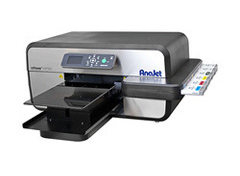
|
AnaJet mPower i-series
- High speed production
- Uses RIP (raster image processor) software
- Industrial print head
- Max print size: 14" x 18"
- 300 to 600 dpi
- CMYK + white inks
- Approx. $14,000
|
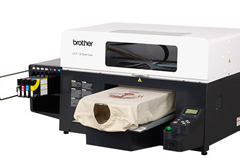
|
Brother GT-361
- Mid-level machine
- 6 print heads, expandable
- Does not require RIP software
- Max print size: 16" x 18"
- Up to 1200 dpi
- CMYK + white inks
- Approx. $15,000
|
| DYE SUBLIMATION PRINTERS
|
 |

|
Epson SureColor F6070
- Industrial machine
- 10-channel inkjet head
- Uses SoftRIP software
- Max print size: 43" wide paper rolls (unlimited length)
- Up to 1440x720 dpi
- 4 color, Ultrachrome inks
- Approx. $8,500
|
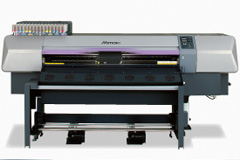
|
Mimaki JV5-130S
- Industrial machine
- 4 print heads
- Max print size: 53" wide paper rolls (unlimited length)
- Up to 1440 dpi
- 4 color and 6 color modes, solvent inks
- Approx. $45,000
|
To place an order:
upload your images online, and select "Fabric Dye-Sub Prints" product.
 |
|
© 2002-2025 - KeenART Media Ltd.
|
|
| |
|

